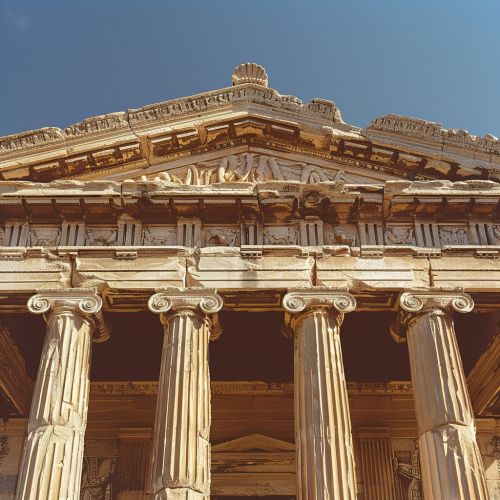Classical style
Classical Style
The term "Classical style" refers to a broad and historically significant aesthetic that emerged in various forms across different disciplines such as architecture, music, and visual arts. This style is characterized by its emphasis on harmony, proportion, balance, and adherence to established forms and conventions. The Classical style has its roots in the art and culture of ancient Greece and Rome and has influenced numerous subsequent artistic movements.
Architecture
Classical architecture is defined by its adherence to the principles and forms established in ancient Greece and Rome. This style is characterized by the use of columns, pediments, and entablatures, as well as a focus on symmetry and proportion. The primary orders of classical architecture are the Doric, Ionic, and Corinthian orders, each distinguished by their unique column designs and decorative elements.


The Parthenon in Athens is a quintessential example of classical architecture, showcasing the Doric order with its sturdy columns and simple capitals. The use of entasis, a slight curvature in the columns, exemplifies the Greek attention to optical illusions and visual harmony. Roman classical architecture, while heavily influenced by Greek precedents, introduced innovations such as the arch, vault, and dome, which allowed for more expansive and complex structures. The Pantheon in Rome, with its massive dome and oculus, is a testament to Roman engineering prowess and their adaptation of classical principles.
Music
In music, the Classical style refers to a period and aesthetic that emerged in the mid-18th century, following the Baroque period and preceding the Romantic era. This period is marked by a shift towards clarity, balance, and formality in musical composition. The Classical period saw the development of the sonata form, symphony, concerto, and string quartet, which became the foundational genres of Western art music.
Composers such as Mozart, Beethoven, and Haydn are central figures of the Classical music era. Their works are characterized by clear melodic lines, structured harmonic progressions, and balanced phrasing. The sonata-allegro form, with its exposition, development, and recapitulation sections, became a standard structural framework for many compositions during this period.
Visual Arts
Classical style in visual arts is marked by an emphasis on idealized beauty, proportion, and harmony. This style draws heavily on the artistic principles and techniques of ancient Greek and Roman art. Classical sculpture, for instance, is renowned for its depiction of the human form in a naturalistic yet idealized manner. The works of sculptors such as Phidias and Polykleitos exemplify the classical approach to proportion and anatomical accuracy.
In painting, the Classical style is often associated with the Renaissance period, when artists sought to revive the techniques and aesthetics of antiquity. Artists like Leonardo, Michelangelo, and Raphael incorporated classical principles of composition, perspective, and anatomy into their works. The use of linear perspective, chiaroscuro, and balanced compositions are hallmarks of the classical approach in visual arts.
Literature
Classical literature encompasses the literary works of ancient Greece and Rome, which have had a profound influence on Western literary traditions. Greek literature, with its epic poems like Homer's "Iliad" and "Odyssey," and the tragedies of Sophocles, Euripides, and Aeschylus, set the foundation for narrative and dramatic forms. Roman literature, with authors such as Virgil, Ovid, and Horace, continued and expanded upon these traditions, contributing to the development of epic poetry, satire, and lyrical poetry.
The classical style in literature is characterized by its emphasis on rhetorical skill, structured forms, and the exploration of universal themes such as heroism, fate, and the human condition. The use of meter, particularly in epic and lyrical poetry, and the adherence to formal structures like the three-act play in drama, are indicative of the classical literary aesthetic.
Philosophy
Classical philosophy, originating in ancient Greece, has been foundational to Western thought. Philosophers such as Socrates, Plato, and Aristotle explored fundamental questions about existence, knowledge, ethics, and politics. Their works laid the groundwork for various branches of philosophy, including metaphysics, epistemology, and ethics.
Plato's dialogues, with their dialectical method, and Aristotle's systematic treatises, such as the "Nicomachean Ethics" and "Politics," exemplify the classical approach to philosophical inquiry. The emphasis on rationality, logical argumentation, and the pursuit of truth are central tenets of classical philosophy.
Influence and Legacy
The influence of the Classical style extends far beyond its historical origins. During the Renaissance, there was a deliberate revival of classical principles in art, architecture, and literature, known as the Renaissance humanism movement. This period saw a renewed interest in the texts and artistic techniques of antiquity, leading to significant developments in various artistic and intellectual fields.
In the 18th and 19th centuries, the Neoclassical movement sought to revive and emulate the art and architecture of classical antiquity. This movement was characterized by a return to simplicity, symmetry, and proportion, in reaction to the excesses of the Baroque and Rococo styles. Notable examples of Neoclassical architecture include the Panthéon in Paris and the United States Capitol building.
The Classical style continues to be a reference point in contemporary art and architecture, with its principles of harmony, balance, and proportion remaining relevant in modern design. The enduring legacy of the Classical style is evident in the continued study and appreciation of ancient Greek and Roman art, literature, and philosophy.
